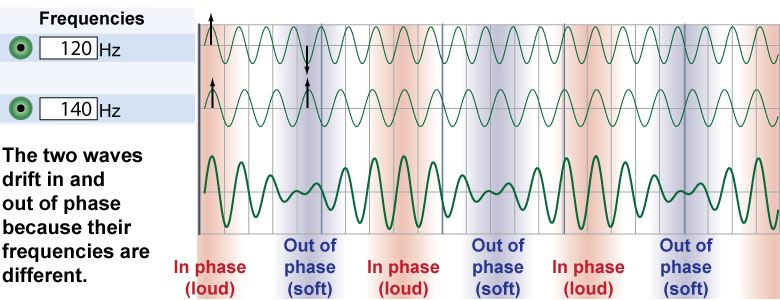|
Interference can result from a phase difference between two or more sound waves. The phase of a wave describes a place in the wave’s cycle with respect to the full cycle. A full wave is usually assigned a phase of 360°. That means a phase of 180° is one-half of a cycle. Two waves are in phase when both begin at the same point in their cycle. Two waves are 180º out of phase when one wave begins one-half cycle ahead of or behind the other wave. Sound waves that are the same frequency add up constructively when they are in phase, or destructively when they are out of phase. 
|

|
When two frequencies of sound are close, but not identical, the sound waves drift in and out of phase and make beats. Sometimes the two waves are in phase, and the total is louder than either wave separately. Other times the waves are out of phase and they cancel each other out, making the sound quieter. The term beats refers to the rapid alternation in amplitude caused by this interference. The alternation in loudness occurs at the beat frequency, which is the difference between the two single frequencies. For example, a 120 Hz sound and a 140 Hz sound interfere to make beats at 20 Hz. The overall loudness of the combined sound would go up and down 20 times per second. In the e-Book, use the interactive tool on the left to investigate beats! 
|

|
Instruments that are out of tune make beats. Many people find beat frequencies between 1 Hz and about 30 Hz unpleasant to listen to. Sounds that create beats are dissonant and may evoke tension and unrest. The frequencies in the musical scale are specifically chosen to reduce the occurrence of beats. The word harmony technically means a combination of sounds that do not make unpleasant beats. 
|
What will happen if two sound waves of the same frequency that are 360° out of phase interfere?
 |
Two waves that are 360° apart in their cycles will be in phase, because they will be one complete phase apart. When they interfere, it will be constructive interference, and the product will be a wave of the same frequency with double the amplitude. 
|

